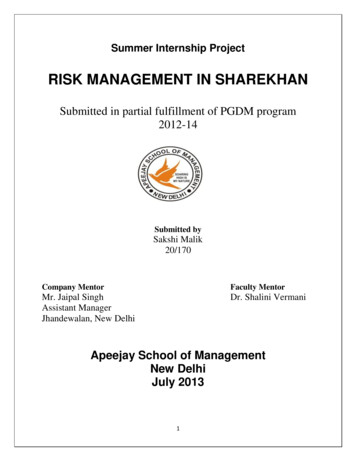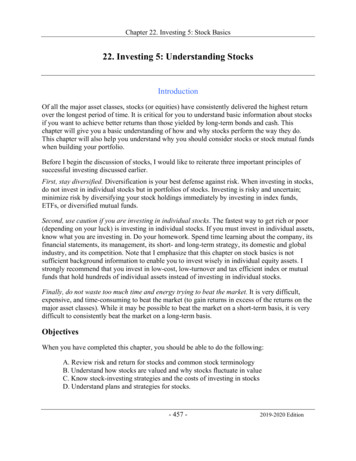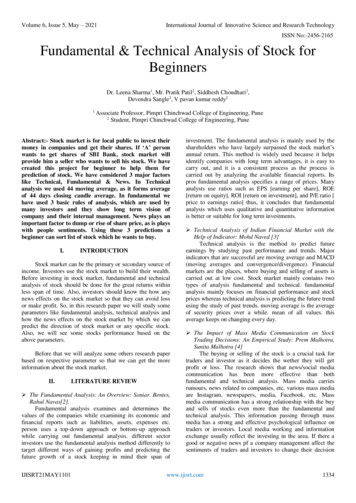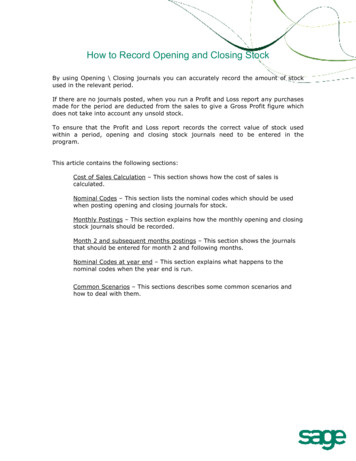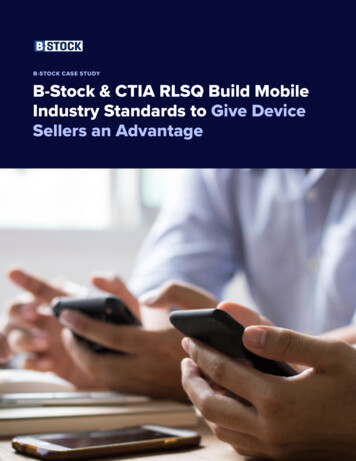
Transcription
B-STOCK CASE STUDYB-Stock & CTIA RLSQ Build MobileIndustry Standards to Give DeviceSellers an Advantage
QUICK FACTS32.7%reduction indepreciation rate37.5%Disputes reduced byincrease in newbidder activation50 %THE CHALLENGEAs phones evolved over the years to become more powerful, reliable, and expensive, business owners recognized ademand among consumers for more affordable pre-owned mobile devices. Used, trade-in, and refurbished devicesfrom manufacturers and retailers would come to fuel a thriving secondary market.The trouble? The many players in this market—manufacturers, carriers, retailers, refurbishers, secondary marketresellers, and consumers—had no shared standard for grading the condition of these devices.While some devices arrived pristine, many came covered in scratches and dings, with shattered screens, weakbatteries, broken charging ports, dead microphones, and other issues. With all the components in a modernsmartphone, there are hundreds of points to consider in evaluating a handset’s condition and, ultimately, its value.Without a common set of grading criteria, refurbishers and resellers buying lots marketed with arbitrary terms like“Excellent” or “Grade B” had very little idea of what they were going to receive, what it would take to repair them, orwhat prices they could expect to fetch from their own customers. This disconnect inevitably led to disputes betweenparties, broken trust between buyers and suppliers, lost time, and wasted cash value.Even when an organization would develop and publish its own device condition standards, business was slowedconsiderably, as constantly learning, interpreting, and comparing multiple grading systems became a barrier toscaling up operations. Buyers and suppliers were unable to sell and receive devices as fast as they liked.B-STOCK CASE STUDY
THE SOLUTIONRecognizing this industry-wide problem, CTIACertification( ), the global leader in certification for themobile wireless industry, gave its Reverse Logisticsand Service Quality (RLSQ) working group the taskof developing a voluntary grading standard for useby device suppliers, wireless operators, insurancecompanies, logistics, parts suppliers and repairorganizations. The group began assembling a board ofexperts representing some of the top stakeholders inthe mobile industry—multiple major carriers, consumerelectronics giants, top insurance organizations,logistics leaders, key refurbishers, and others.B-Stock, an online auction platform that connectsbuyers and sellers of pre-owned mobile devices, hadalso recognized this problem and approached CTIAcertification looking to contribute its expertise. Asthe world’s largest B2B marketplace for pre-ownedmobile devices, B-Stock’s business depends on lowfriction, high-transparency interactions between trustedbuyers and sellers.Having welcomed B-Stock into the initiative, the groupmet regularly to determine an exhaustive list of everypossible aspect of a mobile device’s functionality andthen established a grading system—as granular aspractically possible—for each area.In early 2019, CTIA RLSQ published the first editionof its Wireless Device Grading Scales Criteria andDefinitions. With buy-in from major mobile marketplayers, the resource caught on quickly and is now themost widely used standard for mobile device grading.B-STOCK CASE STUDY“AT&T actively engaged in thedevelopment of the standards,understanding the benefitto Carriers. Alignment to aconsistent process across thesecondary market has drivenincremental value to our programvia increased recovery and lowercustomer disputes. We applaudCTIA for pulling together industryleading companies to developthis standard.”- Kim AllisonDirector LogisticsAT&T
THE RESULTSAs predicted, the widespread adoption of this new standard was helpful to the many different mobile industrystakeholders that adopted it. B-Stock’s sellers in particular were able to earn more money, reclaim time lostinterpreting arbitrary grading, and clear space while improving both the operational velocity and scalability of theiroperations.Buyers, no longer unsure about the exact meaning of arbitrary condition descriptors and independent gradingstandards, felt much more confident in the lots they were browsing. In fact, device price depreciation slowedsignificantly. Historically device prices on our marketplaces would decline at an average of 2.8% per month, butafter B-Stock began encouraging its sellers to adopt the new CTIA standard, depreciation dropped to 1.9% permonth—an impressive 32.7% reduction (see graph below).Average price per unitFlattening the Depreciation Curve:The Price of iPhone Models Over TimeAfter implementing the new CTIAgrading standards, the rate ofdepreciation decreased by 32.7%MonthB-STOCK CASE STUDY
THE RESULTS (CONTINUED)Not only were existing buyers paying more than before, but interest among new buyers rose noticeably—the sixmonths following the adoption of RLSQ’s standards saw a 37.5% increase in the number of new bidders comparedto the 6 months before the transition. With aligned expectations, more users were bidding more decisively on theirdesired lots, putting cash into sellers’ pockets—faster than ever before.Additionally, sellers saw business efficiency rise in a few ways. As the new standard established highly accuratemarket prices, our partners found that they could: Mobilize buyers and increase competition quickly by eliminating the need for them to purchase test lots duringthe onboarding phase Continually compare their prices across other channels to self-benchmark Optimize their disposition choices Better forecast their sales and understand yieldsFinally, both sellers and buyers enjoyed a massive 50.7% reduction in disputes over item condition, mitigatinganother common time sink and preserving seller-buyer relations.Today, the Wireless Device Grading Scales Criteria and Definitions is a living resource and B-Stock continues to offerits expertise to develop new iterations that cover the latest devices and features that the mobile market has to offer.A BOU T B-STO C K SO LUT IO N SB-Stock operates the world’s largest network of B2B marketplaces for unsold goods of all types, no matter thecondition or amount. Our platform connects major manufacturers and retailers directly to vetted secondary marketbuyers around the globe. Our account management team is made up of industry experts who provide dailysupport and auction strategy to help you move out your used, returned, refurbished, or trade-in devices.To learn how we can help, contact us today.A BOU T C T IACTIA’s RLSQ Working Group convenes members representing the entire reverse logistics community toaddress industry challenges, set certification standards for technician training and device grading and developrequirements for service facilities and retail service excellence.Since 1991, CTIA Certification’s trusted programs have created quality and consistency across the wirelessecosystem, translating into best-in-class products for consumers. For more information, visit www.ctiacertification.
then established a grading system—as granular as practically possible—for each area. In early 2019, CTIA RLSQ published the first edition of its Wireless Device Grading Scales Criteria and Definitions. With buy-in from major mobile market players, the resource caught on quickly and is now the most widely used standard for mobile device grading.




